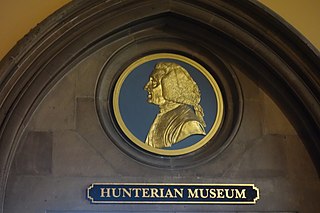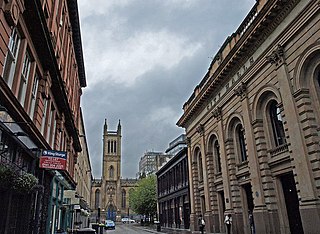
The University of Glasgow's Hunterian is the oldest museum in Scotland. It covers the Hunterian Museum, the Hunterian Art Gallery, the Mackintosh House, the Zoology Museum and the Anatomy Museum, all located in various buildings on the main campus of the University in the west end of Glasgow.

Glasgow Royal Concert Hall is a major concert and arts venue, in the city of Glasgow, Scotland. It is owned by Glasgow City Council and operated by Glasgow Life, an agency of Glasgow City Council, which also runs Glasgow’s City Halls and Old Fruitmarket venue.

The Royal Conservatoire of Scotland, formerly the Royal Scottish Academy of Music and Drama, is a conservatoire of dance, drama, music, production and film in the centre of Glasgow, Scotland. It is one of the oldest and most prestigious performing arts schools in the United Kingdom, and ranked third in the world as of 2017. Founded in 1847, it has become the busiest performing arts venue in Scotland with over 500 public performances each year.

The Pavilion Theatre is a theatre in Glasgow located on Renfield Street.
The city of Glasgow, Scotland, has many amenities for a wide range of cultural activities, from curling to opera and from football to art appreciation; it also has a large selection of museums that include those devoted to transport, religion, and modern art. In 2009 Glasgow was awarded the title UNESCO Creative City of Music in recognition of its vibrant live music scene and its distinguished heritage. Glasgow has three major universities, each involved in creative and literary arts, and the city has the largest public reference library in Europe in the form of the Mitchell Library. Scotland's largest newspapers and national television and radio companies are based in the city.
The Glasgow Museum of Transport in Glasgow, Scotland was established in 1964 and initially located at a former tram depot in Pollokshields. In 1987 the museum was relocated to the city's Kelvin Hall, then moved to its current location in the Riverside Museum building at Glasgow Harbour in 2011.

Glasgow's City Halls and Old Fruitmarket is a concert hall and former market located on Candleriggs, in the Merchant City, Glasgow, Scotland.

The Mitchell Library is a large public library and centre of the City Council public library system of Glasgow, Scotland.

The Theatre Royal is owned by Scottish Opera and is the oldest theatre in Glasgow and the longest running in Scotland. Located at 282 Hope Street, its front door was originally round the corner in Cowcaddens Street. It currently accommodates 1,541 people. The theatre opened in 1867, adopting the name Theatre Royal two years later. It is also the birthplace of Howard & Wyndham Ltd, owners and managers of theatres in Scotland and England until the 1970s, created by its chairman Baillie Michael Simons in 1895. It was Simons who as a cultural entrepreneur of his day also promoted the building of Kelvingrove Art Gallery and Museum and Glasgow's International Exhibitions of 1888 and 1901.

Sauchiehall Street is one of the main shopping and business streets in the city centre of Glasgow, Scotland. Along with Buchanan Street and Argyle Street, it forms part of the main shopping area of Glasgow, containing many of its high street and chain stores.

Knightswood Secondary School is a secondary school located in Knightswood in the west-end of Glasgow, Scotland.

The Alhambra Theatre, Glasgow opened on 19 December 1910 at the corner of Waterloo Street and Wellington Street, Glasgow under the direction of Sir Alfred Butt and was acknowledged as one of the best equipped theatres in Britain, planned to accommodate 2,800 people.

Tramway is a contemporary visual and performing arts venue located in the Scottish city of Glasgow. Based in a former tram depot in the Pollokshields area of the South Side, it consists of two performance spaces and two galleries, as well as offering facilities for community and artistic projects. The Hidden Gardens is situated behind Tramway. The new extension to Tramway is the home of the Scottish Ballet, and is claimed to be one of the leading venues of its type in Europe.
The Royalty Theatre, Glasgow was a theatre in Glasgow at the corner of Sauchiehall Street and Renfield Street. It was built in 1879 as part of a development by the Central Halls Company chaired by David Rattray, and was one of the first theatre designs of Frank Matcham. In 1895 it was one of the four theatres brought together by Baillie Michael Simons of Glasgow in a new company Howard & Wyndham Ltd. The Royalty staged plays, opera, and musical comedy and later became home to repertory theatre until it became the Lyric Theatre in 1914 when it was sold to the YMCA. It was rebuilt after a fire in 1953 but eventually demolished in 1959, and replaced by St. Andrew House, a large concrete office block, which is now a hotel.
The Glasgow Gaiety Theatre was a cine-theatre in Anderston Cross, Glasgow, Scotland. Originally known as the Victoria Music Hall, then the Tivoli Variety Theatre, and co-founded by a grandson of James Baylis of the Theatre Royal, Glasgow it opened in 1899 presenting Musicals, variety shows and pantomimes. When it was rebuilt in 1904 it changed to operate as a cine-variety under the name of Gaiety Theatre, becoming a full cinema in 1935. The Beatles appeared there in 1963. The cinema closed in 1965. It is not to be confused with the Gaiety Theatre, Sauchiehall Street, which became the Empire Theatre.
The Queens Theatre was a theatre in Glasgow, Scotland, situated in Watson Street near Glasgow Cross. It was built in the 1870s to cater for working class Glaswegians. The theatre opened as the Star Hall. It went on to be renamed the Shakespeare Music Hall, New Star Theatre of Varieties and the Peoples Palace Theatre before being named the Queens Theatre in 1897. The theatre was destroyed by fire in 1952.
The Metropole Theatre started as the Scotia and was built in 1862 at 116, Stockwell Street, Glasgow, Scotland. Built to the designs of architect Robert Black for James Baylis, who later built the Theatre Royal in the Cowcaddens area of the city, it opened as the Scotia Hall, holding over 3000 people, with stalls and two galleries, reputed to be the first purpose built commercial music-hall in Scotland. Due to fire in 1875 it was rebuilt to the designs of architects Campbell Douglas and James Sellars and renamed The Scotia Variety Theatre, claiming to be the largest and best variety company in Scotland.
Glasgow Golf Club, founded in May 1787, is the ninth oldest golf club in the world. It has changed location several times during its history, but has been based at Killermont in Bearsden since 21 May 1904. The Club is unusual in also having a links course, at Gailes, near Irvine, on the Ayrshire coast, some 35 miles away.

James Baylis was a theatre entrepreneur and entertainment provider in 19th century Glasgow, where he originated music halls and theatres from the 1840s until his death in 1870. One of his major developments was the Theatre Royal, Glasgow which continues today and is owned by Scottish Opera.
















